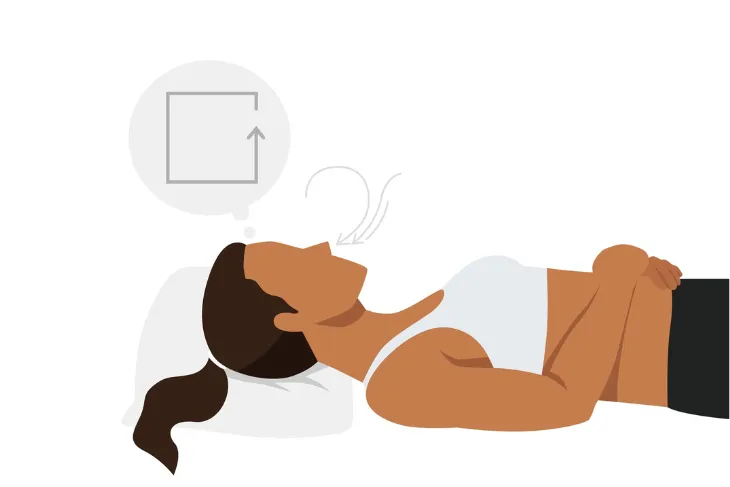- Breathwork refers to any type of breathing exercise or technique.
- This practice involves intentionally changing your breathing pattern to help improve mental and physical well-being.
- While it can be safe, it’s always best to consult your doctor before starting breathwork therapy, especially if you have a medical condition.
Breathwork may not be new but it is becoming increasingly popular. Likely because more people are understanding the benefits of mindfulness and practicing breathwork is one way to be more mindful.
Breathwork also offers tons of health benefits from deep relaxation to feeling energized. Better yet, there are many different breathing exercises and techniques that you can try. If you’re interested in breathwork follow along as we take a look at what it is, the potential benefits it has to offer, plus how to get started.
What Is Breathwork?
Breathing is essential as it provides the body with the oxygen it needs to live and thrive. And breathwork simply refers to any type of breathing exercise or technique. WebMD points out that while it may be trendy now, it’s not new. In fact, breathwork has been practiced for thousands of years and “has roots in yoga practice.”
The source explains that when you are physically or emotionally stressed, your breathing is affected and certain breathing techniques or exercises can help bring your breath back to a healthy rate. As a result, breathwork may help reduce stress and “bring balance to your body.”
Breathwork vs Meditation: What’s the Difference?
While meditation and breathwork may seem similar and may have similar goals, Mind Body Green explains that unlike meditation, “where we are aware of our mental chatter, breathwork allows us to disconnect from the mind and reconnect with our body and energy.”
Another notable difference is that meditation takes time and practice to clear the mind and ease stress, whereas breathwork can provide immediate relief. The source also says that once you learn how to do it, it’s a great tool to use when you’re feeling overwhelmed, stressed, or off-center.
The Benefits of Breathwork
Many people are turning to breathwork for an array of reasons from overcoming addiction to improving creativity. Though more scientific research is still needed, the general consensus is that breathwork can help improve your emotional state and decrease stress in healthy people.
WebMD also notes that breathwork may have a positive impact on your central nervous system. When you’re stressed, your breath often becomes fast and shallow, which reduces the amount of oxygen entering your bloodstream. The source says when this happens, your brain communicates to your body that there is a threat, which puts you in a state of fight or flight. But, when you practice breathing techniques to help you breathe deeper and slower, this tells your brain that there is no threat and in turn helps you de-stress.
Physical and Emotional Benefits of Breathwork
According to WebMD breathwork may offer some physical health benefits. For example, it may help improve your immune system, respiratory function, and blood pressure. It may also help you spend more time in deep sleep which helps you feel more rested and improves cognitive function. Breathwork may also help reduce feelings of trauma.
The source also notes that along with decreasing stress, other emotional benefits include improved mental focus and fewer feelings of anxiety and depression. Breathwork may also improve your outlook on life, and help you feel more content and happy.
Possible Risks of Breathwork
While breathwork does offer tons of benefits, there are some risks that you should be aware of. One concern is hyperventilation which can occur in more advanced techniques. Hyperventilation can be dangerous because it can lead to dizziness, irregular heartbeat, muscle spasms, ringing in the ears, clouded vision, and decreased blood flow to the brain. The best way to avoid this is by learning from a professional or using a guided program.
Healthline states that breathwork is not recommended for individuals who have breathing or cardiovascular problems, high blood pressure, a history of aneurysms, osteoporosis, recent physical injuries or surgery, severe psychiatric symptoms, and vision problems. Consult your doctor before starting breathwork therapy, especially if you have a medical condition.
How to Practice Breathwork
If you’re interested in practicing breathwork, the good news is that there are easy techniques for beginners. Healthline says some of the common types of breathwork include shamanic breathwork, aviation, transformational breath, holotropic breathwork, clarity breathwork, and rebirthing. You may want to try a few to find which one works best for you.
There are also many mindfulness apps available, such as Calm and Headspace, which provides guided recordings. Sessions can range from 2- to 15-minutes. Let’s take a look at some common beginner breathing exercises you can try next.
Breathwork Technique: 4-7-8 Breath
When you’re feeling overwhelmed, anxious, angry, or triggered, give the 4-7-8 breathing exercise a try. It may also help if you’re having difficulty sleeping. The goal of this exercise is to quiet and focus your mind by counting beats as you breathe in and out. By focusing on your breathing, your heart rate will slow, allowing you to focus on the present moment, and in turn, it will bring a feeling of peace. So, how does it work?
Mind Body Green says this technique works by breathing in through your nose for 4-seconds, holding the breath for 7-seconds, and exhaling out of the mouth for 8-seconds. You’ll want to repeat this exercise at least four times. Remember, the goal is to bring a state of calmness.
Breathwork Technique: 4-4-4-4 Breath
Another technique beginners can try is called box breathing, also known as square breathing, or 4-4-4-4 breath. This breathing technique has ancient roots but it is also regularly used by the Navy SEALs to help aid in stress management, calmness, and refining focus. MedicineNet says the name comes from the fact that you divide your breathing into four equal steps.
Start by sitting in a relaxed position and place your right hand on your stomach and exhale heavily, releasing all the air from your chest. Inhale through your nostrils while counting to four and then hold your breath for 4-seconds. Next, slowly exhale out of your nose for 4-seconds and then hold for 4-seconds and repeat. Try to repeat the cycle at least 3 times. The source says the Navy SEALS typically practice this technique for about 5-minutes.
Breathwork Technique: 5-5 Breath
This breathing technique can be practiced throughout the day, especially when you feel yourself getting worked up, explains Mind Body Green. The source explains that our natural breath is usually at a rate of two or three seconds per minute but with Coherent Breathing, also known as the 5-5 breath, you’ll need to slow down your breathing. This technique can bring on an overall sense of calm.
Set a timer for 1-minute and begin breathing in for 4-second followed by exhaling for 4-seconds. Then repeat but this time inhale in for 5-seconds and exhale for 5-seconds and then repeat again but with 6-second intervals. You can gradually increase the cycle up to 10-seconds. The source says you can start with a 5-minute session but as you become more experienced you may want to practice this technique for 20-minutes daily.
Breathwork Technique: Deep Abdominal Breathing
Deep abdominal breathing, also known as diaphragmatic breathing or belly breathing is a technique that helps you use your diaphragm properly while breathing, explains the Cleveland Clinic. This technique can help strengthen your diaphragm, decrease oxygen demand, and helps you use less effort and energy to breathe. So, how do you do it?
The source says start by lying on your back with your head supported and your knees bent. You can place a pillow under your knees to support your legs. Next, place a hand on your upper chest and another just below your rib cage (this will help you feel your diaphragm as you breathe). Then breathe in slowly through your nose, feeling your stomach move out. The hand on your stomach should rise while the hand on your chest should remain still. Then exhale slowly through pursed lips. Practice for 5- to 10-minute sessions. The source also notes when you gain more practice, you can try this breathing technique sitting.
Breathwork Technique: Alternate Nostril Breathing
As the name suggests, alternate nostril breathing involves breathing through one nostril at a time and alternating between both nostrils. Healthline points out that alternate nostril breathing can be done as a part of yoga or meditation practice but it can also be done on its own to help calm your mind.
Start by sitting in a comfortable position and exhale completely. Then place your right thumb on your right nostril and apply pressure to close the right nostril. Next, inhale through the left nostril and then close the left nostril with your fingers, release the thumb and exhale through the right nostril. Then inhale through the right nostril and then close it and open the left nostril and exhale through the left. This is considered one complete cycle. Try to repeat this cycle for a 5-minute session.
Advanced Techniques
While the above exercises are great for beginners other more advanced techniques require practice or the guidance of an experienced instructor. WebMD notes two advanced techniques including the breath of fire and holotropic breathwork. Breath of fire is a quick-paced advanced technique that involves inhaling with relaxed abdominal muscles and exhaling while engaging your core. This technique will require a lot of practice.
Holotropic breathwork, on the other hand, should be done with an experienced instructor because it has the potential to bring about intense feelings. The source explains that the goal of this technique is to “achieve a continuous inhale and exhale pattern with no pause in between.”















